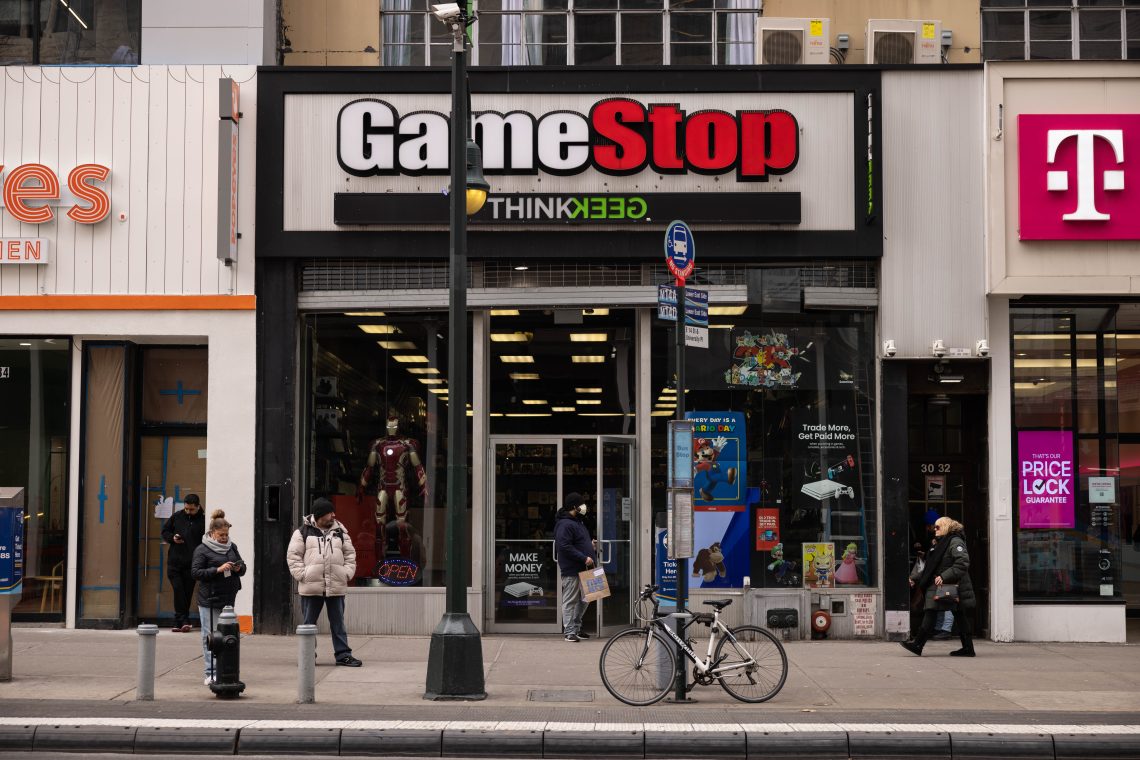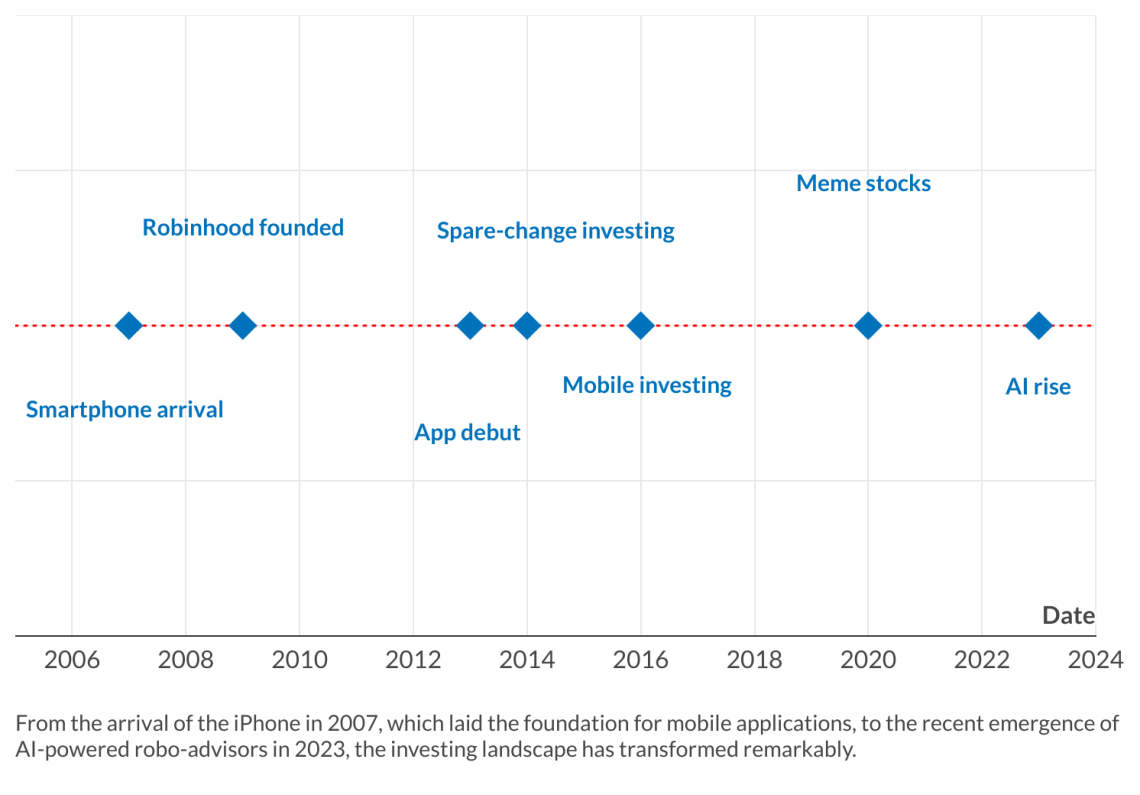The rise (and fall) of the amateur investor
Now that anyone can invest, amateur investors are able to influence financial markets. But this shift comes with dangerous pitfalls.

In a nutshell
- Online brokers have democratized investing
- The rise of “meme stocks” comes with risks
- AI trading tools could herald yet another era in trading
It used to be the case that Americans, being more familiar and comfortable with the stock market, would make the best out of it. Individual investors and even retirees would “play the market.” A lot of times – if not most, they would do very well.
Still, investing was mostly seen as an upper-middle-class pursuit, as the fees, investment minimums and even the knowledge required were prohibitive for most citizens. As for Europeans, stocks were even more inaccessible. The average employee, taxpayer and saver, would not dream of investing in stocks personally, and even if they did, they had no efficient way to do so.
However, the last decade ushered in a new era: the “democratization” of investing. Online brokers popped up, first in the United States and then in the rest of the world, offering affordable, straightforward ways for investors to buy and sell assets directly. As competition picked up and mobile trading apps started taking over, fees dropped fast – first to a few dollars, then to a few cents and even to zero in some cases.
Facts & figures
Opening an account became simpler and quicker. The proof of competence or other basic knowledge questionnaires that investors had to fill in before opening a trading account were soon replaced by essentially symbolic tests that are nearly impossible for anyone to fail. As for the account minimums, they are a thing of the past. You can even start trading with a single dollar today, as many of the new brokers allow fractional trades, enabling investors to hold a piece of a stock.
Many experts saw this shift as a solidly positive development. It certainly appeared that way at first glance. Everyone can now profit from the equity market booms, not only the rich. While this sounds great, upon closer inspection there are some serious caveats that need to be considered.
New investment era
The removal of the income barrier to investing enticed a lot of people that never had the chance to try and dabble in stocks earlier. The vast majority of new “investors” were millennials. A lot of these new market participants, especially the younger ones, had looked on from the sidelines during the first crypto boom and all the overnight millionaires it minted. Perhaps they did not pay attention to the subsequent bust and its aftermath. The boom era gave rise to a dangerously misguided mentality. Much like crypto trading became a social contagion, the stock market too was seen by many newcomers as a huge casino, in which anyone can “win big” – all you have to do is play and look at the “strategies” of previous winners.
Education, or even a basic understanding of investment principles, soon became irrelevant. Why bother reading about P/E and Sharpe ratios and pore over quarterly reports and other tedious things like that, when there is a simpler way to go about finding the next hot stock? You can just scroll down your social media feed, join a forum, or follow the advice of a 19-year-old YouTuber that claims to have made $200,000 over the last two days. This is where the democratization of investing took a dangerous turn. Doing away with the income barrier was great for investors and for the markets too, but the removal of the knowledge barrier had far-reaching implications.
The rise of the “meme stock” is a great example of this. The pump-and-dump schemes of the 1980s and 1990s were masterminded by bad actors to create artificial buzz around a stock, inflate its price and then sell it before gravity takes over. But there is no one in particular that stands to benefit from a meme stock boom. There are online forums, notably on Reddit, where investors try to coordinate their efforts to push prices higher, but it is all quite transparent. They know that what they are buying is junk and there are no false promises, or “hot tips” involved. A lot of them do profit from the exponential price jumps, but profit and profit alone does not seem to be a satisfactory explanation for this phenomenon.
More by Vahan P. Roth
Generative artificial intelligence: Rise of the machines
The CBDCs are coming: Should we worry?
The most famous meme stock to date, GameStop (GME), demonstrated the complicated motivations and the real “fuel” behind the craze. For many GME investors, the focus was not financial, not entirely at least. It was political. The memories of the 2008 financial crisis and its aftermath were still fresh in the minds of the public. As more and more people were now in the stock market arena, it did not take long for them to realize the power they had, or at least could have, if they united against a common foe. Major hedge funds, big banks and short sellers were obvious targets.
And so, in January 2021, we witnessed the short squeeze of the century, all orchestrated by everyday people with comparatively small accounts. That was a much-needed and hopefully constructive lesson for the financial industry, but unfortunately it was an even bigger and much more bitter lesson for all the small investors. They learned the hard way that if you gamble in the market casino, the house always wins. Indeed, on January 28, with GME over $500 pre-market (nearly 30 times the valuation at the start of the month), Robinhood, the main trading app the investors were using, simply suspended trading.
Naturally, the incident attracted a lot of attention and drew accusations of market manipulation. The big firms can create a global financial crisis, with basically no consequences, but when the “little guy” starts winning a bit too much, someone pulls the switch and ends the game? That was the gist of the argument – and it is a fair grievance – but there was another aspect that was very much under-discussed in this debate.
What allowed the “masses” to execute this short squeeze in the first place? What were the mechanisms and the dynamics behind it? How do these trading platforms even turn a profit if they are offering essentially free trades? As the saying goes in the social media space, “If you are not paying for the product, you are the product.” The business model of most of these apps is quite straightforward: they are not charging users a percentage on the orders, they are selling the orders themselves to market makers, in a practice known as “payment for order flow.” Therefore, the trading apps have a clear incentive to maximize the number of orders that users execute on their platform. This is why, even beyond the low-to-no fee appeal, most of them have added addictive and gamified features, social interaction elements and a host of other “nudges” to keep the users on the app, to keep them trading and engaged.
Scenarios
One of the most obvious consequences of this trend is malinvestment and distortion on a massive scale.
If more and more market participants are encouraged to trade just for trading’s sake, with no knowledge, no information, and no sound investment strategy (other than copying peers), then whatever links still remain between the stock market and reality will soon be severed.
Government interventions and aggressive monetary policies, like endless money printing and artificially low rates, have already made sure that the picture painted by markets is extremely distorted. But if the last tether to reality is cut too, if the organic or real demand is corrupted as well, then we might indeed soon find ourselves in a huge online casino.
There is another possible outcome that seems to be more likely. Professional investors, and especially traders, have been heavily relying on computers for years already. “Algo-trading,” proprietary software and other complex systems have been employed in search of that ever-elusive “edge.” Now, with the explosive rise and spread of artificial intelligence, it is only a matter of time before the aforementioned little guys get access to those tools too.
Robo-advisors have been around since 2008, but they failed to really take off. They were simple, crude tools, meant to help amateur investors manage basic buy-and-hold positions. They had no “edge,” as they were based on rather rudimentary algorithms. What if they became supercharged, though, and were powered by AI? We are already getting a glimpse into this scenario: As the Financial Times reported in early May, a theoretical fund of 38 stocks created by ChatGPT outperformed the 10 most popular funds on the British investment platform Interactive Investor. Given that ChatGPT is not even designed to do this job, one can only imagine what a purpose-built AI could achieve.
Would that spell the end of investing as we know it? Will it become just another job to outsource to the machines? It is conceivable, to be sure. However, it might also reignite interest in real, well-researched and well-thought-out long-term investments that are not focused on short-term “bets,” but that add true value both to the companies one invests in and to the economy as a whole.









